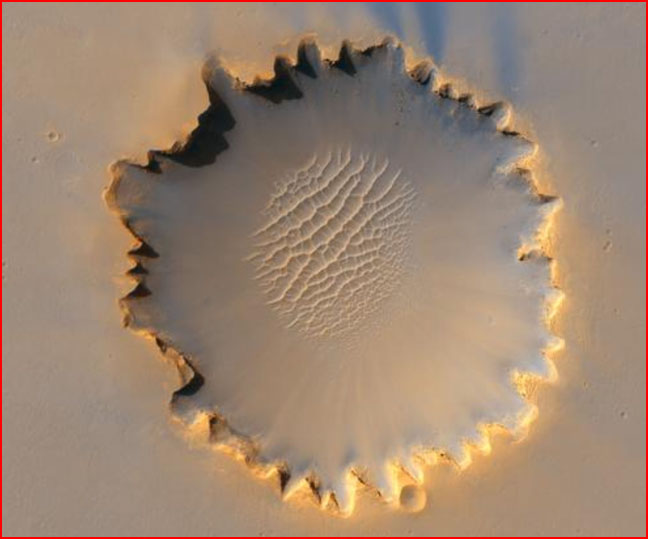
home •
about •
essential guide •
picture of the day •
thunderblogs •
news •
multimedia •
predictions •
products •
get involved •
contact
picture of the day archive subject index
Victoria Crater at Meridiana Planum near the equator of Mars, reveals a cleanly cut “cookie cutter”
profile—another challenge to the impact hypothesis. CREDIT: NASA/JPL/Univ. of Arizona
May 01, 2007
Victoria Crater on Mars
Sharply scalloped walls, together with cleanly cut ridges and valleys on its floor, make Mars’ Victoria crater an ideal test of the electric discharge model of crater formation.
The image above was taken by the High Resolution Imaging Science Experiment on NASA's Mars Reconnaissance Orbiter. It shows “Victoria crater,” whose features can only deepen the growing mysteries of cratering patterns on Mars. It certainly does not look anything like the effect of an impact event, but that is the interpretation given it by NASA. The NASA release, though referring to “a distinctive scalloped shape to its rim,” can only explain this remarkable configuration in terms of “erosion and downhill movement of crater wall material.”
But look at the high-resolution image here. The required debris along the base of the cliffs is simply not there. Direct observation suggests that the sharply scalloped walls are a pristine record of the original causative event.
When questions of theory and interpretation arise, the most compelling answer will be the one that is based on observational fact and can account for essential features left unexplained by alternatives. Electric Universe proponent Wallace Thornhill has recently examined NASA’s reports on Victoria crater. His analysis is based on practical laboratory experiments with electrical discharge, particularly the effects of an electric arc on a positively charged surface – the “anode” in a discharge event. Thornhill states, “Victoria crater appears to be a short-duration anode scar, or ‘spark’ crater, where melting is insignificant. In laboratory experiments it is found that the anode spark scar on a ‘contaminated’ surface develops many arc ‘spots’ at the center of a roughly circular scar. In a very short time the central arc spots move out to form a ring. The spots enlarge and join into a ring. For a time the entire arc current passes through the annular ring. If it were to continue, melting would occur, obliterating the fine scalloped structure of the crater wall. In experiments there may be a hundred or more spots.” See Thornhill’s discussion of Victoria crater here, in particular his illustration of the migrating arc spots from a congregation in the center to a ring. His conclusion: “The scalloped crater wall is simply the erosion signature of the irregular ring of enlarged anode spots.”
And what of the remarkable “ridge and valley” complexes in the center of the crater? According to NASA, this feature is explained as “sand dunes,” supposedly formed by winds in an atmosphere less than one percent as dense as Earth’s. It’s easy to understand why most planetary scientists accept this default interpretation: what else could they be? But as we intend to show in forthcoming installments in this series, almost all of the “sand dune” interpretations of Martian geology are “blown away” when subjected to closer examination.
![]()
home •
thunderblogs •
forum •
picture of the day •
resources •
team •
updates •
contact us
EXECUTIVE EDITORS:
David Talbott, Wallace Thornhill
MANAGING EDITORS:
Steve Smith, Mel Acheson
CONTRIBUTING EDITORS: Michael Armstrong, Dwardu Cardona,
Ev Cochrane,
C.J. Ransom, Don Scott, Rens van der Sluijs, Ian Tresman
WEBMASTER: Brian Talbott
Copyright 2007: thunderbolts.info
